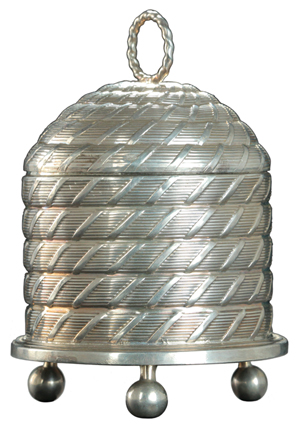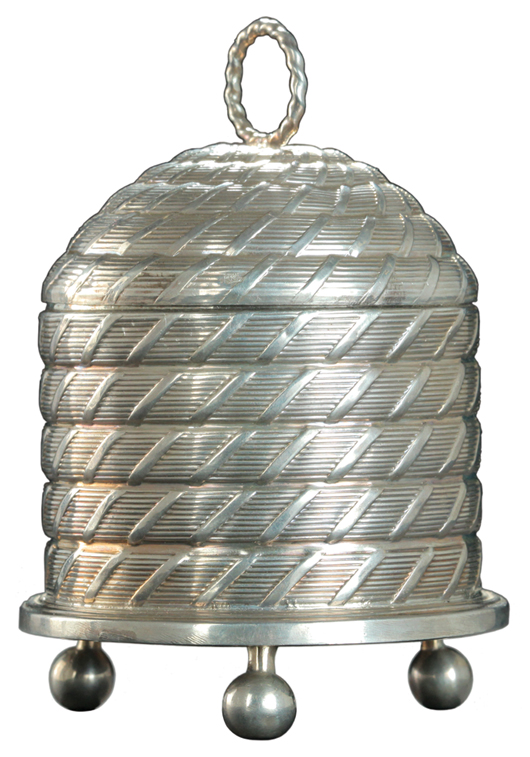
Honey has a history going back to 2100 B.C. It is mentioned in some Babylonian writings. It was used for sweetening food, for medicine, for religious ceremonies and even as a form of money.
In the 18th and 19th centuries, a special serving dish and usually a special serving fork or spoon were devoted to each type of food, so it’s not surprising to find special antique honey pots. The wealthy used silver serving pieces, and honey pots might be shaped like bee skeps or have a sculpted or engraved bee as decoration. Domed skeps were made of woven straw and were portable. If a skep was not destroyed to get honey out, another swarm of bees could inhabit a skep the next season. Old skeps sell today for about $50 to $100 as decorations. It is illegal to raise bees with a skep today. Beekeepers must be able to open hives today so mite medicine can be applied.
Old and new honey pots can be found made of glass and pottery. If you plan to use a sterling- or silver-plated pot, it must have a glass liner. Honey encourages silver tarnish, and tarnish destroys some of honey’s nutrients.
Q: I have an original program from the Candlestick Park Dedication Dinner held at the Garden Court of the Sheraton-Palace Hotel in San Francisco on April 11, 1960. It’s autographed by a few baseball players and by some of the people who spoke at the dedication, including Vice President Richard Nixon, Major League Baseball Commissioner Ford Frick, Giants owner Horace Stoneham and Giants manager Bill Rigney. What is it worth?
A: The San Francisco Giants played at Seals Stadium for two seasons before Candlestick Park opened in 1960. The team played there for 40 years, until its new ballpark on San Francisco Bay (now called AT&T Park) opened in 2000. Your program would interest collectors of baseball memorabilia, but the Nixon signature means it also might appeal to people who want political collectibles. If you want to sell, contact an auction that specializes in sports collectibles. The program could sell for $100, but it might also bring $500 or more, depending on the program’s condition and the fame of everyone who autographed it.
Q: I still have my Alice Marble wooden tennis racket my parents gave me when I was about 10 years old. It was made by Wilson and reads “Court Queen” on the handle. Is this of any value, or is it just a piece of tennis history?
A: Tennis player Alice Marble (1913-1990) was ranked No. 1 in the world in 1939. She broke world records when she won the singles, doubles and mixed doubles titles at both Wimbledon and the U.S. Open that year. During World War II, she was a spy for the United States and was wounded when trying to get some Nazi financial information. Wilson made more than one model of Alice Marble tennis rackets. The Court Queen model was introduced in about 1938. Old wooden rackets aren’t particularly valuable today. Rackets like yours sell for under $40. They are hung on the wall as decoration, not used to play tennis.
Q: We have a set of toy American Indians that consists of 11 figures, including the chief, an Indian on horseback with bow and arrow, another Indian with a gun, a female figure and others. They were in my husband’s family for years. The box they’re in reads, “Elastolin, Made in Germany.” I would appreciate any information you can give me.
A: Elastolin is a trademark used by toy manufacturer O. & M. Hauser of Stuttgart, Germany. The company was founded in 1904 by Otto and Max Hausser. In 1912 Hauser began making miniature military figures out of a mixture of sawdust and glue. The figures were hand-painted and marked “Elastolin.” Figures representing soldiers from many wars, medieval characters, cowboys and Indians and other figures, including animals, were made in several sizes. Figures representing members of Nazi organizations and their leaders were made in the 1930s. The figures of Hitler, Goring, Goebbels and other Nazi leaders had movable right arms that could be raised in the Nazi salute. No figures were made between 1943 and 1945, when German industries concentrated on the war effort. Hard plastic figures were made beginning in 1955, and soft plastic figures beginning in 1970. Production ceased in 1983. Your American Indian figures are sought by collectors. Depending on complexity and condition, the figures sell online for $10 to $100.
Q: I inherited 13 Bessie Pease Gutmann prints when my cousin died. They are all framed and look very old. Some are named and several are not. I would like to know how to find out what they’re worth.
A: Bessie Pease Gutmann (1876-1960) was an American artist who did illustrations for advertisements, books, magazines, postcards and calendars. She is best known for her prints of babies and young children. She stopped working in 1947. Her prints have been mass-produced. Original prints were done on matte paper and include the print number and the name and city of the publisher, “Gutmann and Gutmann, New York, N.Y.” Titles on early prints were written in block letters. Later, prints had titles in script. Original prints can be worth a few hundred dollars, while copies sell for as little as $10 to $15 each.
Tip: Help your family by always identifying who’s pictured in your family photographs. Include their names and ages, the year the photo was taken and where it was taken. Write on the back near the edge using the kind of permanent marker sold at photo supply stores. Do not use a ballpoint pen. It will leave a dent in the paper.
Need prices for collectibles? Find them at Kovels.com, our website for collectors. More than 84,000 prices and 5,000 color pictures have just been added. Now you can find more than 856,000 prices that can help you determine the value of your collectible. Access to the prices is free at Kovels.com/priceguide.
Terry Kovel answers as many questions as possible through the column. By sending a letter with a question, you give full permission for use in the column or any other Kovel forum. Names, addresses or email addresses will not be published. We cannot guarantee the return of any photograph, but if a stamped envelope is included, we will try. The volume of mail makes personal answers or appraisals impossible. Write to Kovels, Auction Central News, King Features Syndicate, 300 W. 57th St., New York, NY 10019.
CURRENT PRICES Current prices are recorded from antiques shows, flea markets, sales and auctions throughout the United States. Prices vary in different locations because of local economic conditions.
- Postal telegraph badge, “All America Cables,” globe, blue-and-white cloisonne, triangular, 2 1/8 x 1 7/8 inches, $45.
- Wallace Nutting print, The Quilting Party, signed, framed, 10 x 12 inches, $50.
- Yellow Kid paperweight, metal, figural, “Say, ain’t I a heavyweight,” R.F. Outcault, 7 x 3 inches, $130.
- Walking stick cane, antler handle, black trim, nickel silver cap, c. 1885, 36 inches, $185.
- Barber shop sign, globe, hand lettered, white, 16 1/2 inches, $210.
- Edwardian chair, domed slatted back, medallion, feathers, down-swept arms, square legs, c. 1900, 36 inches, $430.
- Pier table, mahogany, cove-molded frieze, scrolls, columns, serpentine shelf, c. 1835, 37 x 39 inches, $985.
- Reverse-painted lamp, autumn landscape shade, metal base, Moe Bridges, c. 1920, 24 x 18 inches, $1,180.
- Lalique Verone vase, flared sides, frosted birds, scrolls, ring foot, 1980s, 7 1/2 x 11 inches, $1,230.
- Tea caddy, George III, fruitwood, pear shape, c. 1810, 6 1/4 inches, $2,360.
Available now. The best book to own if you want to buy, sell or collect – and if you order now, you’ll receive a copy with the author’s autograph. The new Kovels’ Antiques & Collectibles Price Guide, 2013, 45th edition, is your most accurate source for current prices. This large-size paperback has more than 2,500 color photographs and 40,000 up-to-date prices for more than 775 categories of antiques and collectibles. You’ll also find hundreds of factory histories and marks, a report on the record prices of the year, plus helpful sidebars and tips about buying, selling, collecting and preserving your treasures. Available online at Kovelsonlinestore.com; by phone at 800-303-1996; at your bookstore; or send $27.95 plus $4.95 postage to Price Book, Box 22900, Beachwood, OH 44122.
© 2013 by Cowles Syndicate Inc.

ADDITIONAL IMAGE OF NOTE



